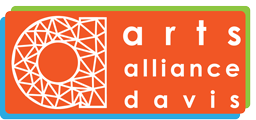
25 Feb Davis Media Access: Concern for the creative economy
by Autumn Labbé-Renault
As the name implies, Davis Media Access is a community media center, but it’s generally classified under the larger umbrella of arts and culture organizations. This is one of those things that has bearing as we apply for grants, but it also plays out in our day-to-day work, as we teach both media technology and media arts.
One of the hats I wear in our community is as chair of Arts Alliance Davis. We’re a coalition of arts-minded folks from all around Yolo County: we’re artists, we staff diverse arts organizations, and we promote arts opportunities. In normal times, we meet approximately six times per year to network and strengthen the arts in Davis and beyond. I love this role, as I’ve learned much about many hidden gems (people and places) across Yolo County.
It’s been an excruciatingly hard year for many of our participating organizations and artists. As Julie Baker of CA Arts Advocates recently noted on Facebook, “From the CA $227 billion budget, CA is in good shape financially with a $15 billion projected surplus. Preliminary read for creative industries, looks like state arts agency stays around the same with $25 million for Cultural Institutions in grants in the next round of $575 million for small businesses.
“It is a start but considering the devastation to the creative industries as compared to our economic impact pre-COVID (larger than that of both construction and transportation) it is simply not enough,” Baker said.
You read that correctly—and in her December presentation to Arts Alliance Davis, Baker said, “Arts are 8 percent of the state’s economy, yet artists are often not seen as essential – or even recognized as workers. Two-thirds of artists are self-employed and don’t qualify for traditional unemployment. Some are truly starving artists.”
Like our fellow arts and culture nonprofits, DMA has had some opportunities for Paycheck Protection loans, but we’ve lost out on event, services and grant income, and an underwhelming amount of relief funds has gone to arts in Yolo County, or indeed, statewide, with notable exceptions. And at the federal level, the Save Our Stages Act was a tremendous step forward, but only addresses one aspect of an evolving crisis.
A recent article in the the Chronicle of Philanthropy encapsulates this particular tension nonprofits are experiencing well (“Nonprofits Lost 50,000 Jobs in December” https://bit.ly/3cD4qK9) notes that “Nonprofits shed an estimated 50,760 jobs in December [2020], a ‘striking reversal’ of what had been months of slow-but-steady job growth among nonprofits, according to a new report from Johns Hopkins University. As a result, nonprofits employed nearly 930,000 fewer workers in December than they did in February, before the pandemic, a 7.4-percent decline.”
The article details how arts and culture nonprofits continue to be the hardest hit, noting that since the start of the pandemic in March 2020, such nonprofits have lost 130,360 jobs, or 36.6 percent of roughly 355,965 jobs.
In Davis, last year’s Civic Arts Grants were cancelled (the City’s Arts & Culture Fund has been able to fund a few projects that span both arts and social justice, but the small annual grants many independent artists rely on were cancelled), while neighboring Sacramento spent $19.8 million of CARES Act funding on the local creative economy.
In the arts, we sometimes refer to ourselves and our organizations as “second responders.” It’s a term coined by Californians for the Arts, (and you can read an excellent op ed they wrote: https://bit.ly/2NZ5jCo), but in short what it means is, “First responders save lives; second responders help put people’s lives back together. Artists are essential workers in our society and our economy, helping us recover, reflect, and rebuild.”
I frame it this way: the arts help us sift through and make sense of what happened, and provide context and meaning as we move forward.
I’ve had many conversations with funders and community leaders throughout the pandemic, and they’ve run along these lines: “people are giving according to Maslow’s hierarchy,” or “right now, we just need to focus on feeding, housing and caring for people.” I get that — and I don’t disagree with those needs, but I’m struggling with the widespread shutout of arts funding, and what that means for our future.
The truth is —I know of a few local nonprofits that are counting how long they can stay in business in weeks, and several more who are doing the same in months. So, what happens when life is normalized, and people are once again looking for after-school programs, summer camps, internships, and other enrichment opportunities that in normal times make up a large portion of our local arts and culture nonprofit services?
Meanwhile, there’s information to be had, and some virtual services and creative pivots to explore. I invite you to visit https://artsalliancedavis.org for an overview, and Arts Alliance Davis on Facebook for frequent updates on local events and opportunities. My gratitude to City Arts & Culture Manager Rachel Hartsough for her tireless work to connect us all.
— Davis Media Access (DMA) is the only nonprofit community media center in Yolo County. KDRT 95.7 FM is a project of DMA. Autumn Labbé-Renault has served as its executive director since 2007, where she writes and blogs about a wide variety of media issues. Tune into KDRT 95.7 FM/https://kdrt.org Tuesdays at noon for her radio show, the “COVID-19 Community Report.” Learn more at http://davismedia.org, email info@davismedia.org, or call (530) 757-2419.
